Kayak is a great way to explore the water and its many wonders. Whether you’re looking for a leisurely paddle, an exciting whitewater adventure, or a fishing trip of a lifetime, kayaks can provide endless opportunities. But before you embark on your journey, it’s important to find the right kayak for you. Buying used is a great way to get the perfect fit at an affordable price.
When shopping for a used kayak, the most important goal is to find one that fits you. Whether you’re tall or short, heavy or light, there’s a kayak out there that will suit your body type and needs. In our blog post on “how to buy a used kayak”, you can learn more about what to look for in a used kayak.
Contents
Contents
Is Purchasing A Used Kayak Right Choice?
The short answer is yes! There are a lot of benefits to buying used. You can save money by purchasing a gently used kayak instead of paying full price for a new one. Plus, you may even be able to get your hands on a model that’s no longer available, because newer isn’t always better.
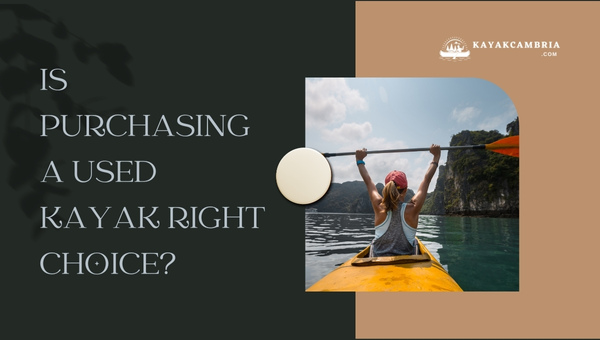
You can sometimes get a kayak with all the bells and whistles for the same amount of money, rather than settling for a cheaper kayak. If you’re just getting into paddling or looking to dip your toes in without breaking the bank, then buying used may be the way to go.
It’s an affordable introduction to kayaking, allowing you to reap all the benefits of kayaking without spending a lot of money. No matter what you’re looking for, buying used can help you find the perfect fit at an awesome price. Just make sure you do your research and inspect any potential purchases thoroughly.
What Is The Best Time To Buy A Used Kayak?
This is where timing comes into play. When it comes to buying a used kayak, timing is everything. Different times of year offer different advantages, so if you’re looking to score a great deal on a second-hand kayak, pay attention to the calendar.
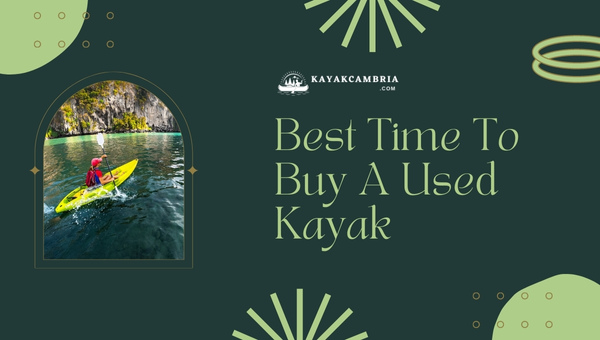
The prices of used kayaks will remain more or less consistent year-round, but there are still certain times of the year that can be beneficial. During summer months, the prices of used kayaks tend to be slightly higher due to the increased demand for recreational water sports.
In winter and early spring when demand is low, you may find better deals on used kayaks. The best time to buy a used kayak is during the late fall or early winter when demand is low and prices are at their lowest and the end of the kayaking season. This way, you can get a great deal and still have plenty of time to enjoy your new kayak in the upcoming season.
Things To Look For While Buying A Used Kayak
There are plenty of things to look for when buying a used kayak. It’s important to inspect the condition of the kayak, both inside and out. Below are some things to look out for:
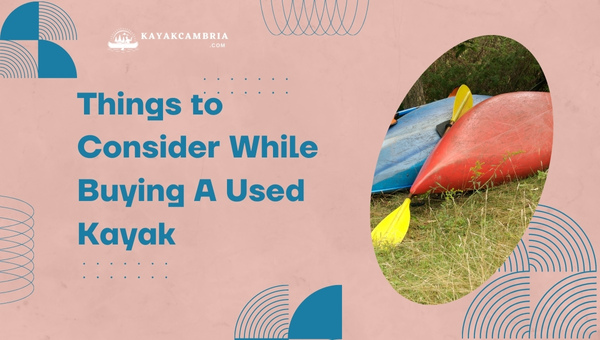
1. Type of Kayak You Need
The first and foremost thing you need to consider is what type of kayak you’re looking for. All kayaks are not designed with the same purpose and environment in mind, so you need to make sure that the kayak you’re looking at is suitable for your intended use. While buying a used kayak, make sure to check the features and specs you would usually check when buying a kayak. There are a few features that you should consider are:
- The Design: Consider whether you’d like a sit-on-top or a sit-inside kayak.
- Construction and Materials: Check the kayak’s material, construction, and durability for wear and tear.
- The Kayak’s Dimensions: Check the length and width of the kayak to make sure it fits your body type.
- Maximum Load Capacity: Make sure you know how much weight the kayak can safely support, including both cargo and passengers.
- Onboard Storage Options: Look for tie-downs, bungee rigging, and storage hatches that allow you to take your gear with you.
- Included Accessories: Look for accessories like seat cushions or paddles that come included with the kayak.
2. Know About the Seller
You should also take the time to do your research on the seller. After all, you’re buying a used kayak from some random person on the Internet. Make sure they are legitimate before you commit to any purchase. The more information you have about the seller and their background, the better. Also, make sure that they offer clear return policies if there is an issue with your purchase.
3. How Was It Stored?
The way a kayak is stored can affect its value and functionality. Kayak hulls, particularly those made of plastic, are vulnerable to distortion if improperly stored. This can cause the performance-dependent part of the boat to take the full weight of the kayak when it’s in use. Therefore, you should check how the kayak has been stored.
Ideally, it should be stored off the ground and out of direct sunlight. If it has been stored outside, check for signs of mold or mildew growth if not covered. Some types of mold secrete chemicals that can damage a kayak’s hull. So, make sure to inspect the kayak thoroughly before buying it.
4. Inspection of Kayak
Once you’ve decided on a kayak, it’s time to inspect it. Take a good look at the kayak and assess its condition. This includes looking for signs of wear and tear, checking the integrity of seams and stitching, and inspecting any accessories that come with them. When you’re inspecting a used kayak, make sure to check out the following:
- Hull: The hull is the foundation of the kayak and will bear the brunt of any wear and tear. In a plastic kayak hull, look for any significant warping of its lines by flipping the boat, as well as deep dents or thin points due to drag damage. In a thermoformed kayak, look for the same deep dents and warping as you would in a plastic kayak. Also pay attention to the ABS (Acrylonitrile Butadiene Styrene) material that is used to make thermoform hulls, as it can become brittle if exposed to the elements. And look for any cracks around the cockpit rim and edges.
- Rudder: A rudder is a blade attached to the stern of a kayak that is used in tandem with foot pedals to control direction. When checking the rudder, make sure to check for erosion or degradation of its components and that the machine is operating correctly. You should also find out if replacement parts for that particular model are still available in the market.
- Skeg: A skeg is a blade that drops from the bottom of the boat and helps the paddler track and trim in high winds. It typically has no moving parts and should be checked for any potential collision or drag damage. You should also test the cables to make sure they’re functioning properly, and inspect the skeg for any cracks or damage by pouring water into the skeg box to see if it leaks.
- Hatch Covers: The hatch covers help to seal up the storage spaces in the kayak hull, keeping gear safely stowed and preventing water from getting in. Check the hatch covers to make sure they open and close properly, and that the rubber seals that keep them watertight are in good condition. Look for any signs of rot or damage, as well as missing parts. Make sure the seals are capable of keeping the water out.
- Deck rigging: The deck rigging should be inspected for any signs of wear and tear, such as fraying or loosening. Make sure the hardware is secure and tight, such as zip ties, bungee cords, lacing, etc. It’s also important to check the ropes or cords that crisscross the kayak deck. They should be strong and in good condition, providing grab holds for paddlers as well as allowing a spot for paddlers to attach water bottles, map bags, and paddles. Also, make sure these ropes are securely fastened to allow the use of rudders and skegs.
- Cockpit Outfitting: This includes foot pegs, knee pads, and thigh braces. Check these to make sure they are in good condition and securely attached to the kayak hull. Also, check the hardware making sure it is not rusted or corroded.
- Kayak Seat: You’ll want to check the kayak seat for any signs of UV damage and fraying, and see if adjust it for a customized fit. Additionally, inspect for comfortable padding on the seat, as well as any straps or buckles that are used to secure it.
- Bulkheads: Bulkheads are vertical walls inside your kayak that run from the hull up to the deck. They provide flotation and help avoid flooding in the kayak. Lower-quality boats usually only have one bulkhead, while higher-quality boats typically have one at each end of the kayak. Make sure they’re in place, intact, and working properly.
- Hardware: Make sure all the hardware is present, including cleats, mooring rings, or handles, as well as any of the other pieces that make up the kayak’s hardware system. Check for any corrosion and piece of equipment for signs of damage due to wear.
- Accessories and Extras: Finally, check any extras that come with the kayak such as rod holders, gear tracks, and other accessories. Make sure they are in good condition and functioning properly or you may find yourself without some vital pieces of equipment.
5. Take the kayak for a test paddle
Once you’ve inspected all of these components, take the kayak for a test paddle. This will give you a better feel for how well the boat handles, its stability, and its tracking ability. It’s also a good idea to bring along a friend who can help spot any potential problems that may not have been noticed during the inspection. Check the following aspects as you go:
- Leaks: Make sure there are no leaks and that the kayak is watertight.
- Outfitting: The outfitting, such as knee pads and thigh braces, is adjustable and comfortable.
- Tracking performance: Check how well it tracks in a straight line and if any rudder or skeg controls are needed to help it stay on course.
- Handle: Make sure the kayak is easy to handle and you feel comfortable while paddling it.
- Cockpit: There should be enough room inside the cockpit and your hips and knees rest comfortably against the sides.
- In and out of the kayak: Try and learn whether it’s easy to get in and out of the kayak.
- Comfort: Seating needs to be comfortable so that you can paddle without any discomfort.
- Wear and tear on the kayak: If any signs of wear and tear that could affect the performance or reliability of the kayak.
- Stability: Lastly, check how stable the boat is and make sure you don’t feel like you’re going to tip over.
How Much Does A Used Kayak Cost In 2025?
The cost of a used kayak can vary significantly depending on the brand, model, and condition. Generally speaking, they can range from 50 percent to 75 percent of their recommended retail price. It’s important not to go into this with a fixed price in mind as the fits your needs should be the priority when buying a used kayak, not the price.
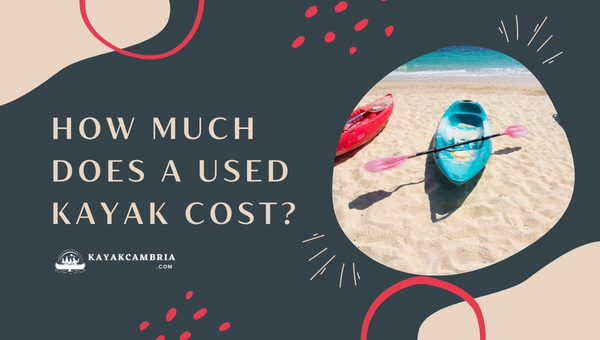
It’s also important to be mindful of any damage to the kayak, especially if the damaged parts need to be replaced, you should negotiate the price with the seller or decline the sale. If you’re unsure of what a fair price for a used kayak would be, research the current prices of a new one and consider the used kayak’s condition, age, and damage.
What Are The Best Places To Buy A Used Kayak?
Buying a used kayak can be tricky since you don’t always know what condition it’s in. To ensure quality, try to purchase your kayak from a reliable source. Here are some of the best places to get a used kayak:
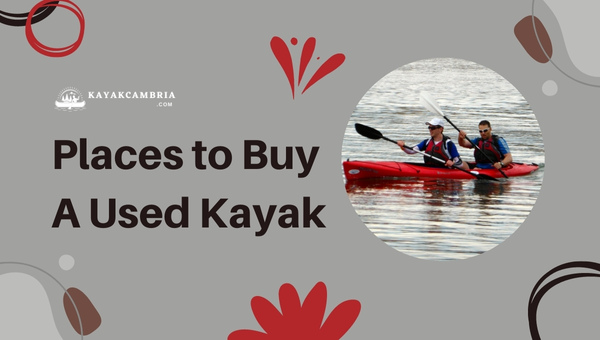
1. Online
With sites like Craigslist and eBay, you can have access to more sellers and a larger selection of used kayaks. It’s also a good place to begin your search since the prices may be lower than what you find in retail stores. However, look for signs that the seller is legitimate. The more information is provided about the seller as well as the product, the more likely that the situation is genuine.
If you feel uneasy or if the price seems remarkably low, then approach with caution. There’s the potential to get ripped off if you’re not careful. You should also be aware that kayaks come with a Hull Identification Number and if this number has been scratched off, then you may be dealing with a stolen boat. Many online stores or manufacturers may also offer used kayaks for sale.
2. In-Person
Buying in person can be a bit of a hassle since it takes more time. But it’s not impossible. You can check around local sports and fishing stores, or visit flea markets or kayaking events. But if you’re looking for more selection, then you may want to consider online options. There are many resources from where you can buy a used kayak as follows:
- Local Paddling Clubs: You can get in touch with local kayaking clubs and talk to the members about whether they may have any used kayaks for sale or know someone who does.
- Garage Sales: The great thing about garage sales is that you can get a fantastic deal. You just have to be careful because they’re not as dependable. Not every garage sale you come across will have used kayaks for sale, so it may take some time and effort to find the right one for you.
- Flea Markets: You can also get a good deal in a flea market, though it’s not as common to see kayaks. Due to transportation issues, you may need a vehicle that can accommodate the size of a kayak for this option. This can be a great option if you live in an area that’s more water-centric. It’s not unusual to see kayaks and other watercraft for sale at these places if you live near a lake or river.
- Local Retailers: If you have good connections with any local retailers, you may be able to pick up a used kayak from them. Many of these stores may also offer discounts on used models that they’ve taken in as trade-ins.
Frequently Asked Questions
1. Is buying a used kayak a good option?
Yes, buying a used kayak is often a great way to get value for your money. It’s important to understand that the condition of the kayak can affect its price and you should be ready to negotiate if needed.
2. Where can I buy a used kayak?
You can buy used kayaks online, at local sporting and fishing stores, flea markets, garage sales, or even from local retailers. You may need to do some research to find the best deals.
3. What is the average cost of a used kayak?
The price of a used kayak will depend on its condition, age, and damage. To ensure you’re getting a fair price, research the current prices of a new one and consider the used kayak’s condition.
4. When is the best time to buy a used kayak?
This depends on when you need it, as well as the season. Generally, you can find great deals in the off-season such as late fall or early spring. Additionally, if you’re looking for certain brands that have gone out of production, then it may be worth searching online ahead of time because they tend to go fast.
Final Words
With some patience and perseverance, you can find a used kayak that fits your budget and needs. In our blog post “how to buy a used kayak”, we’ve outlined the different ways to go about finding and buying used kayaks. We hope this guide has helped get you started on your journey to finding a great used kayak. Good luck!

